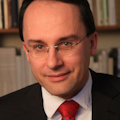Nobel Prize 2018 awarded 'for groundbreaking inventions in the field of laser physics'
When Donna Strickland received the call on October 2, 2018, she could not believe it: "It's crazy. That was my first thought," she later admitted in the press conference from the Royal Swedish Academy of Science. But it was all real: The Nobel Prize in Physics will be awarded to three laser scientists for truly groundbreaking inventions.
Arthur Ashkin from Bell Laboratories (Holmdel, NJ) will be awarded half the prize "for the optical tweezers and their application to biological systems." Ashkin invented optical tweezers that grab particles, atoms, viruses, and other living cells with their laser beam fingers. A major breakthrough came in 1987, when Ashkin used the tweezers to capture living bacteria without harming them. He immediately began studying biological systems and optical tweezers are now widely used to investigate the machinery of life.
Laser Focus World editor Kathy Kincade gave insights to this technique in a feature on "OPTICAL TOOLS - Trapping with light ...fantastic."
The second half of the prize will be equally shared by Gérard Mourou and Strickland "for their method of generating high-intensity, ultra-short optical pulses." This method is well known as chirped-pulse amplification (CPA) and it has revolutionized the generation of energetic ultrashort laser pulses. Laser Focus World Senior Editor John Wallace gave a good overview on the technology and its devices in 2015.
Strickland, a former president of the Optical Society of America, is the third woman to receive this price prize after Marie Curie (1903) and Maria Goeppert-Maier (1963).
The basic idea was discovered by Mourou and Strickland in the early 1980s and published in 1985, and it was the foundation of Strickland's doctoral thesis. It had a huge impact on various fields of femtosecond science ever since.
A first real-world application became feasible in ophthalmology, where ultrafast lasers replaced excimer lasers in LASIK procedures. Today, they can even do cataract surgery, the most common surgical procedure in the world.
Amplified femtosecond lasers for micromachining became an option in the early 1990s, also inspired by Mourou: "Dr. Gérard Mourou, then a professor at the University of Michigan and a founder of the MXR portion of what became Clark-MXR in 1992, was the first to recognize that femtosecond pulses of light ablated material in a more deterministic manner and with less heat-affected zone (HAZ) than longer laser pulses," said Bill Clark from Clark-MXR in an interview.The future of CPA is currently established in Eastern Europe: Funded by about one billion euros, the Extreme Light Infrastructure (ELI), with institutes in the Czech Republic, Hungary, and Romania, builds a new generation of ultrastrong ultrafast lasers. As Mourou said in an interview in 2011, this project was one that he had on his agenda when he returned to Europe after 28 years in America.
"With the new lasers, we will produce extremely high laser intensities for fundamental scientific research," says Georg Korn, Scientific Director of ELI Beamlines, the Czech ELI pillar. "There are almost no limits.” And he also sees the future applications: "We will generate x-rays and beams of accelerated particles. Those will have applications in medicine, imaging science, and many fields of basic research." With accelerated particles, lasers may become new tools for a precise noninvasive treatment of cancer."
But for Mourou, that is just the beginning. In 2016, he co-authored an article on "High-energy Lasers: Extreme light in zeptoseconds." Laser power beyond any imagination will enable a new kind of physics, where particles are forced to appear out of the vacuum. He summarized that visionary article, saying "This achievement will not only provide the aforementioned all-optical understanding of high-energy physics phenomena, but will underpin new compact sources of protons, neutrons, and muons with more applications in fundamental physics, and for societal applications like compact proton therapy or nuclear waste transmutation."
To watch the announcement of the 2018 Nobel Prizes in Physics, see https://youtu.be/sWsXyhuRoXo.
About the Author
Andreas Thoss
Contributing Editor, Germany
Andreas Thoss is the Managing Director of THOSS Media (Berlin) and has many years of experience in photonics-related research, publishing, marketing, and public relations. He worked with John Wiley & Sons until 2010, when he founded THOSS Media. In 2012, he founded the scientific journal Advanced Optical Technologies. His university research focused on ultrashort and ultra-intense laser pulses, and he holds several patents.


